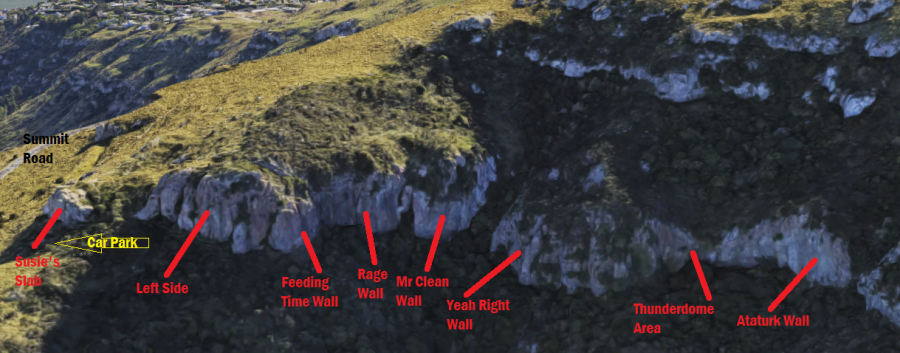Steep, sustained routes are the hallmark of this excellent crag. Although very steep or overhanging, most routes are infested with holds of all shapes and sizes and are not very technical. Strength is a definite advantage though and they do require some thought and determination to place adequate pro. Most routes have had enough ascents to be clean of loose holds but footholds still tend to crumble occasionally.
The cliff is pleasantly cool on hot days, being sheltered from the nor'west. Some of the climbs are so overhanging that short showers may pass un-noticed. It gets wet from seepage after rain. The Ataturk wall is sheltered from the easterly, and unlike the rest of the crag gets afternoon/evening sun, making it a good choice for after-work sessions.
Climbing Notes
Many of the routes have bolts and hangers, and belay/rappel anchors exist at the top of most routes (notable exceptions being Pumping Velvet and Salome Malone. Descents are usually a scramble along the top and down the side of the crag, avoid crossing the fenceline at the top of the crag as the land beyond this is private property (it's almost always preferable to abseil). Any easy route is usually an unpleasant gully. Even the bolted routes may require (or at least accept) gear between the bolts - and several routes have their bolts well spaced. Pack your brave pills and your flying goggles.
Line topos are approximations of the actual route position
History
Little had been done here up until 1970 except for aid routes, with Stu Allen being a big contributor. 1971 saw work from Ross Gooder resulting in **Gooder's Line (16). In the next ten years only five routes were added, probably the best being Fantasia (17) by Rob Rainsbury in 1975. Then in 1982 Lyttelton Rock was refound. John Visser did the unrelentingly steep **Scratching Julius (21) up an old aid line, which started a feeding frenzy by Lindsay Main and Joe Arts in 1982-83. Great climbs such as **Feeding Time at the Zoo (21), *Bombs Away (21), *Suppressed Personalities (20) (all Arts), and *The Promised Land (17) and Rubicon (21) (Main) date from then. In 1984, Ton Snelder and Roger Parkyn hopped on the wagon. With this new blood and bigger and better bolts to protect the steep walls, the cliff gave superb test-pieces like ***Getting Rid Of Mr Clean (23) and **Pumping Velvet (23) (Snelder) and serious propositions like **The Active Ingredient (21) (Parkyn). Their efforts culminated in the publishing of a now-classic guidebook in 1985. Where possible, their original route descriptions have been used.
Things then slowed, but didn't stop. In 1987, Steve Schneider added Stars and Stripes (23) up one of the old aid lines. Dave Fearnley also made contributions, with Drop the Bomb (26) and the phenomenally steep ***Rage Sur La Plage (25). The late 80s saw the ascent of Gone Bimbo (27) and other steep things before the quest for horizontal rock lead people to the Superbowl aka The Cave. Activity then ceased through most of the mid-90s.
Tony Burnell's arrival in 1996 saw a rebirth, with many new routes (Red Wall, Cli Revisitied, Spoonerism, Ground Effect, Buddies, Jug Jockey, Art For Arts Sake, Timberlands, Striking Distance, Salome Malone), and a few other people snuck in some new climbs as well (Kynan Bazley with Rock Shock and John Chambers with Idol Boys).
Access is from the Summit Road where the Major Hornbrook Track crosses on its way down to Lyttelton, between the top of Mt Pleasant and the Mt Cavendish. From the gate the first small buttress (Suzie's Slab) is visible. From there an obvious track leads over to and around under the rest of the crag.
The crag forms part of a DOC-administered botanical reserve, since it represents one of the best examples of native vegetation in a south-facing, shady microclimate. Some species here are fairly sensitive, so don't rip into the vegetation.
Lyttelton Rock has been carefully assessed by NZAC members for loose rocks that may have been dislodged by recent earthquakes. Any suspect rocks have been removed, and the crag is as safe as it can be. As always there is the risk of rock-fall in the event of another major earthquake, but because all known loose rocks have been removed, the cliff is probably safer than it was before the earthquakes.

Does anyone know any information about the climb between Frank's in a Frenzy and Art for Arts Sake in the Thunderdome? Starting by fighting over the bulge and then into a little crimpy section which is followed by jugs to the top finishing next to A4A?
In reply to Does anyone know any by Scott Jury
Don't know its name, but it's about 24. I believe Tony Burnell did the first ascent.
In reply to Don't know its name, but it's by petemoore
Haha, oh good. I thought I was having to try really hard on Arts Sake for a moment before realising it was the one next to it.
Lyttelton Rock access information updated following discussions with DOC.